Score breakdown
Things we like
- Interior quality
- Plenty of space
- Pricing is competitive
- Interesting range of powerplants
Not so much
- Hybrid can be unrefined
- Infotainment's questionable ergonomics
- Ride quality isn't great
- Hard to cancel driver aids
Mazda has launched a lot of large-ish SUVs in the past couple of years but make no mistake, as far as Australia is concerned, the CX-80 is the big ticket item.
It sits alongside the now-established flagship CX-90 as the brand’s seven-seat offerings, but where the CX-90 is unashamedly premium, the CX-80 is campaigning at a far more affordable sticker price.
Thing is, when you’re sitting behind the wheel, such is the impression of quality that you’d be hard-pushed to realise that fact and that could well be the CX-80’s trump card. It opens at just $54,950 for an all-wheel drive seven-seater, which means that it’s cheaper than equivalent rivals like the Hyundai Santa Fe or the Toyota Kluger. Heck, that’s mid-range Mitsubishi Outlander money. Do we now have your attention?
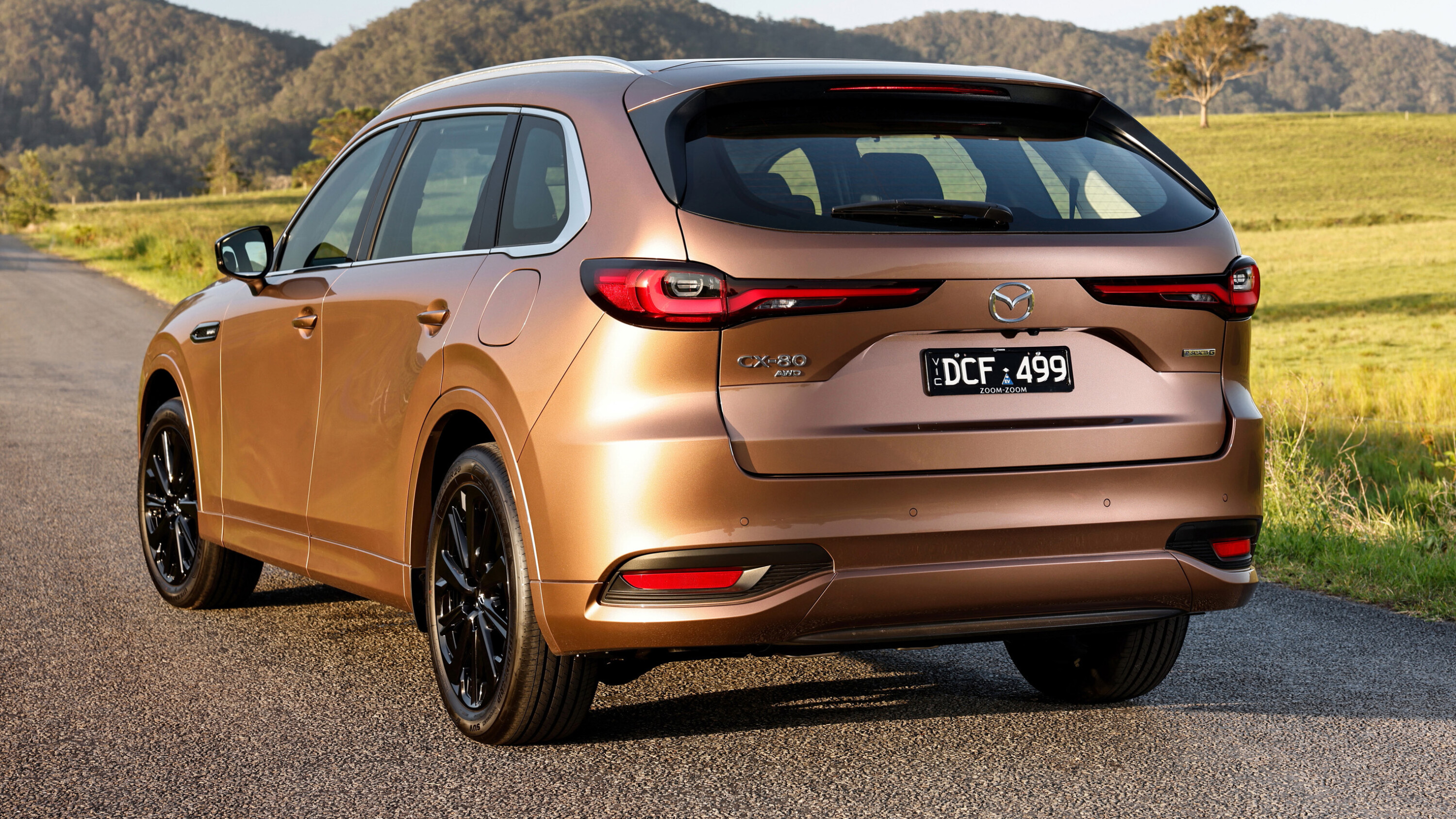
JUMP AHEAD
- How much is it, and what do you get?
- How do rivals compare on value?
- Interior comfort, space and storage
- What is it like to drive?
- How is it on fuel?
- How safe is it?
- Warranty and running costs
- VERDICT
- Specifications
How much is it, and what do you get?
What’s more, that $54,950 opener isn’t buying you some dud that’s designed purely to generate footfall into Mazda’s dealerships.
It nets you the Pure grade which is expected to be the second most popular of the four trim levels rising through Pure, Touring, GT and Azami that are equipped with the 3.3-litre straight-six mild hybrid petrol engine. Yep, that’s correct, the range opener gets a 209kW/450Nm heap of shove.
The equivalent Santa Fe coughs up a mere 172kW. The Kluger serves a paltry 184kW. In other words, Mazda is delivering plenty of engine.
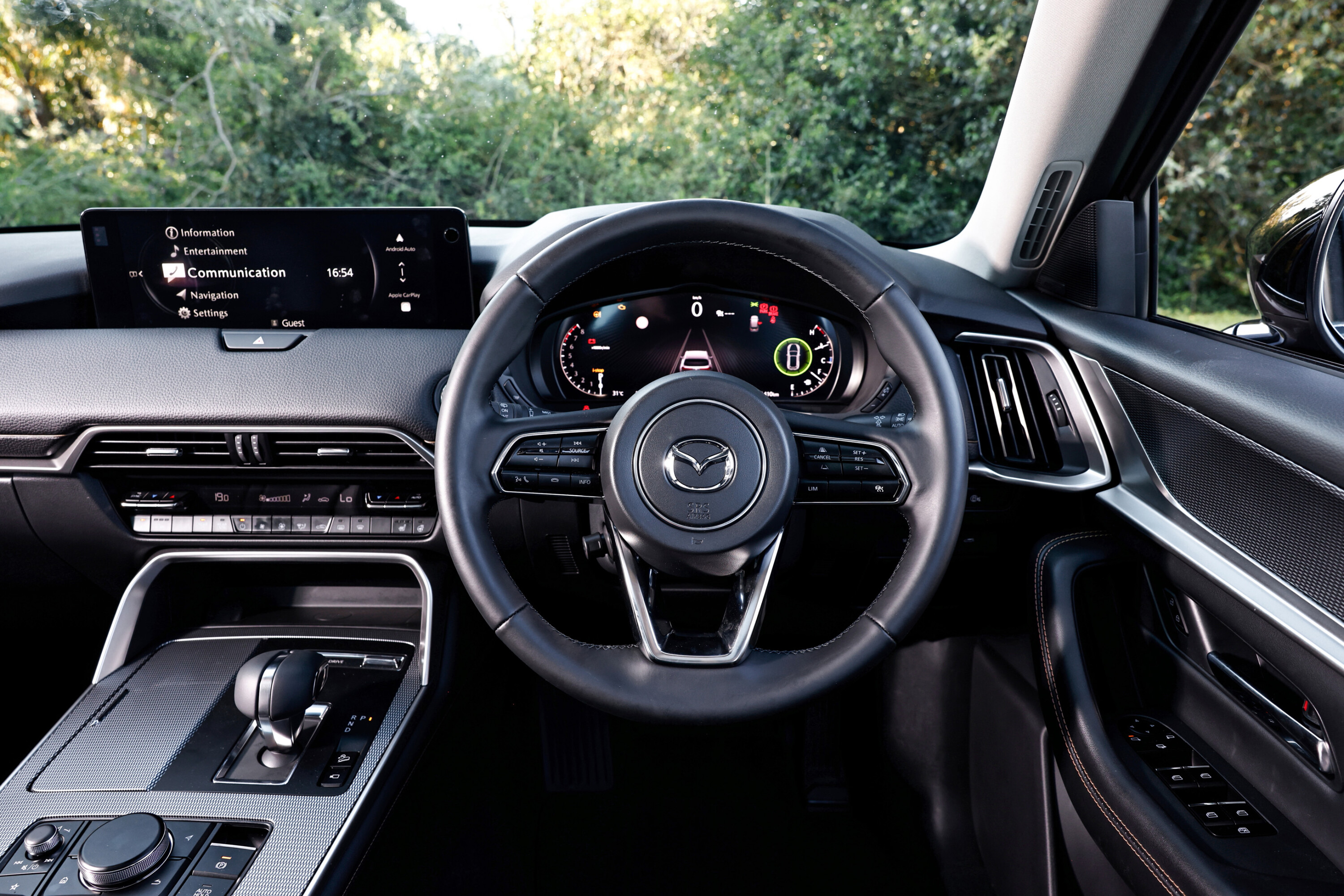
You’ll need deeper pockets if you want a 3.3-litre straight-six diesel engine, largely because these start at the $63,950 for the better-equipped Touring grade, a premium of $2000 over the petrol Touring.
The value proposition gets a bit hazier if you’ve got your heart set on one of the 2.5-litre plug-in hybrid versions of the CX-80 which open in Touring guise at $75,000. Unless you’re very disciplined with metering out its electric range, you’d likely need to cover moonshot mileages to recoup that additional outlay in terms of fuel savings.
The Pure specification, available only with the petrol engine, includes 18-inch grey metallic alloys, a 10.25-inch centre screen with a 7-inch TFT multi-information meter, wireless Apple CarPlay and Android Auto, LED headlamps with high beam control, native sat nav and Mazda Connected Services.
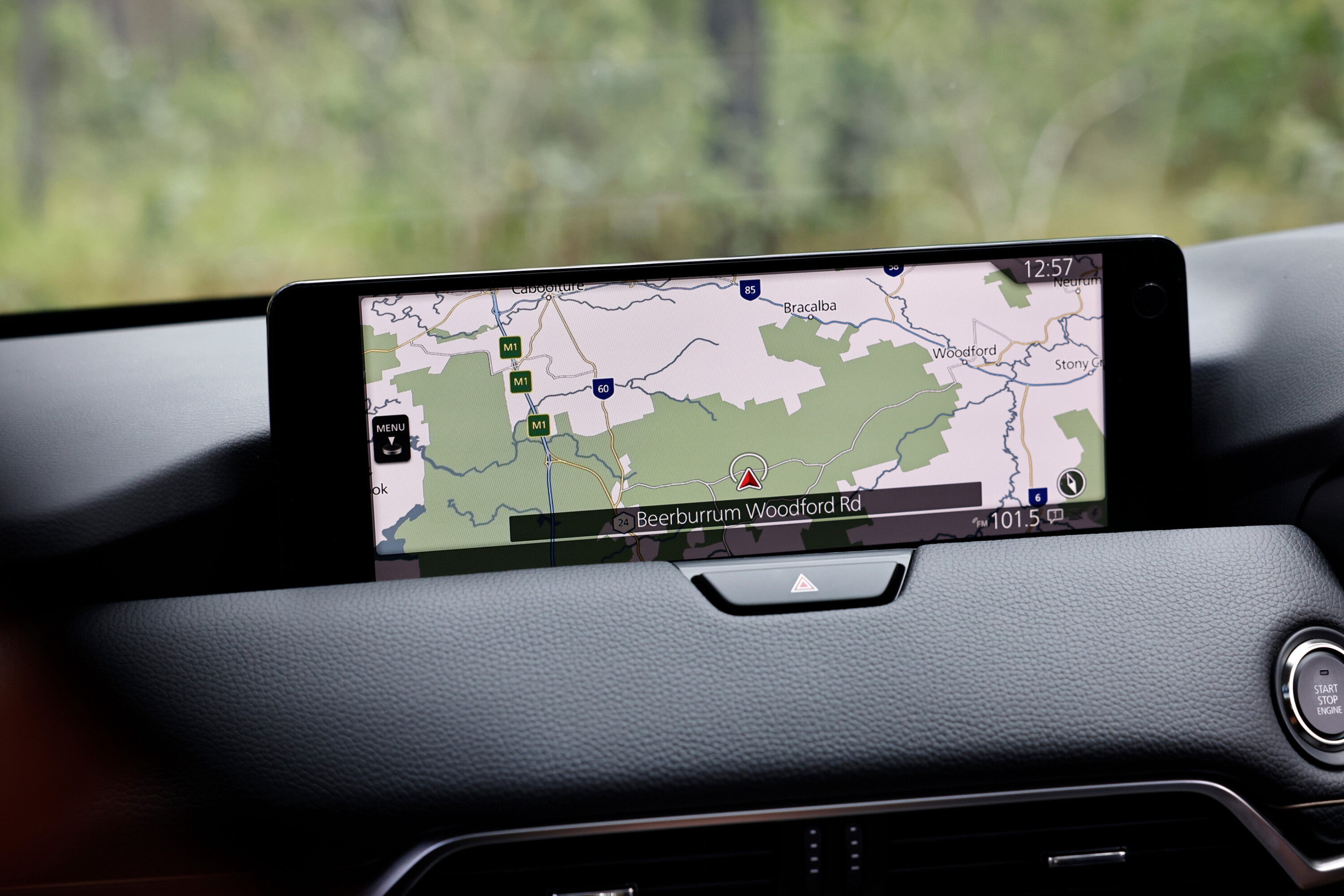
Step up to the Touring and you’ll net a larger 12.3-inch centre screen, leather upholstery, seats with heating power adjustment for the front occupants and a memory function for the driver, a remote operated tailgate and a wireless phone charger.
The GT grade, expected to be the most popular, throws in 20-inch black metallic wheels, a panoramic sunroof dual 12.3-inch screens, body-coloured wheelarches and lower body cladding, heated seats in the second row, a heated steering wheel and a premium Bose stereo with 12 speakers.
The flagship Azami trim features black nappa leather for the seats, Cruising & Traffic Support (CTS), LED headlamps with bright signature, ventilated front seats and a personalised system with easy entry and driving position guide.
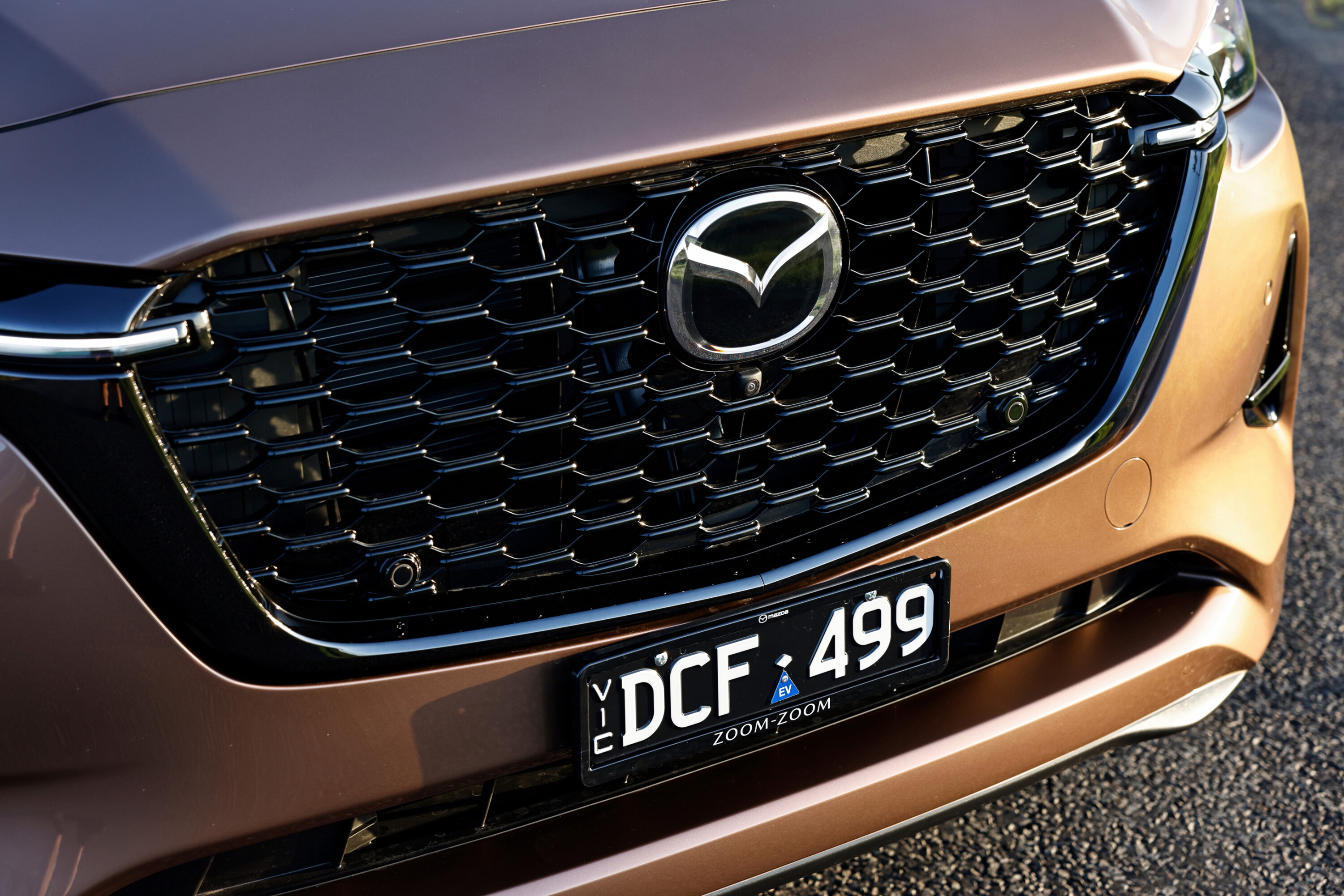
Should you be feeling particularly flush, you can also spec the Azami with the $5000 SP pack which includes tan nappa leather, gloss black honeycomb grille and mirrors, dark-finished LED headlights, a suede dashboard panel, a two-tone steering wheel and second row captain’s chairs.
Should you spec that onto a plug-in hybrid CX-80 Azami, the sticker price climbs to a not insignificant $92,200. Less can be more.
Eight body colours are offered. Deep Crystal Blue Mica, Platinum Quartz Metallic and Jet Black Mica are offered at extra cost while the hero colour is Melting Copper Metallic, Rhodium White Metallic, Artisan Red Metallic, Soul Red Crystal Metallic, and Machine Grey Metallic all attract a $995 surcharge.
| 2025 CX-80 model | Engine | Drivetrain | Price |
|---|---|---|---|
| Pure | 3.3L Turbo Petrol | AWD | $54,950 |
| Touring | 3.3L Turbo Petrol | AWD | $61,950 |
| Touring | 3.3L Turbo Diesel | AWD | $63,950 |
| Touring | 2.5L PHEV | AWD | $75,000 |
| GT | 3.3L Turbo Petrol | AWD | $68,950 |
| GT | 3.3L Turbo Diesel | AWD | $70,950 |
| GT | 2.5L PHEV | AWD | $82,000 |
| Azami | 3.3L Turbo Petrol | AWD | $74,150 |
| Azami | 3.3L Turbo Diesel | AWD | $76,150 |
| Azami | 2.5L PHEV | AWD | $87,200 |
| Prices exclude on-road costs | |||
How do rivals compare on value?
When you pause to consider that the Mazda CX-80 is, in effect, a stretched version of the five-seat CX-60, it appears extremely strong value, in an intra-company sense at least.
A 3.3-litre petrol CX-60 GT is priced at $68,400 while the equivalent CX-80 retails at only $550 more. That money buys you a vehicle with a whole extra 250mm grafted into its wheelbase, and when it comes to packaging people, wheelbase is key.
So let’s consider that measure for a moment against, say, Toyota Kluger. This is, by most people’s measure, a very large family SUV, yet the tale of the tape shows that the wheelbase here is a mere 2840mm to the CX-80’s 3120mm. Overall length of the Toyota is also down on the Mazda, with the Toyota measuring 4966mm stem to stern and the CX-80 a nadge bigger at 4990mm.
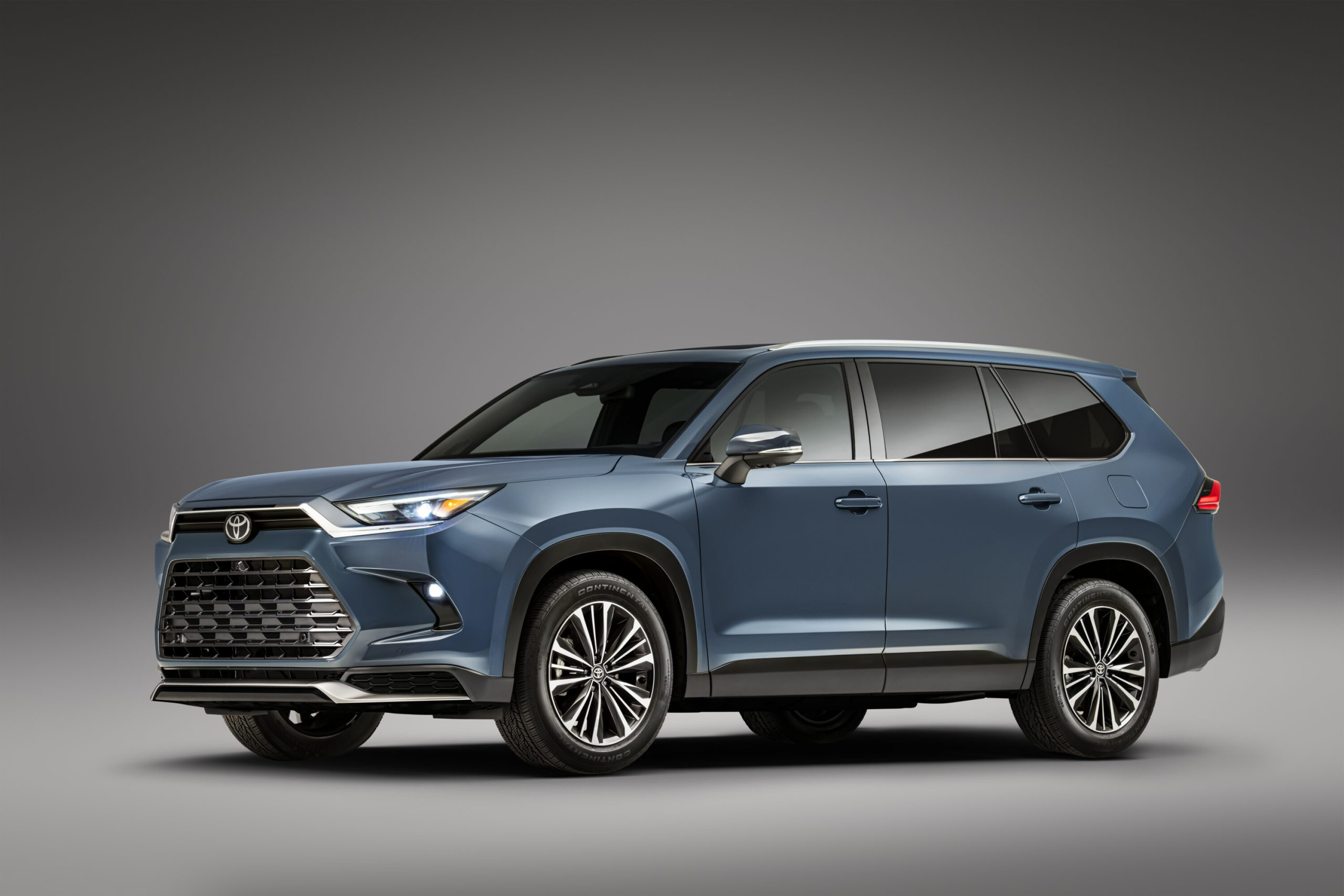
The Kluger’s 2.5-litre hybrid engine is notably down on peak power and the popular GXL mid level grade costs nearly $68,000 for hybrid petrol.
That’s almost on par pricewise with the CX-80 GT petrol ($68,950) and there’s no doubt that the Mazda is better equipped and presents better, even if its 48v mild hybrid system isn’t anything like as economical as the Kluger’s full hybrid powertrain.
How about the box-fresh Hyundai Santa Fe? That’s a class act and is offered in petrol hybrid across the board. Again the Hyundai scores in terms of overall fuel parsimony, but you’d need to spend $75,000 on the range-topping Calligraphy model to get yourself a version of the Hyundai that feels as if it nears the Mazda’s interior finish and sense of occasion. Again, the Hyundai is considerably shorter (4830mm) and smaller in between its axles (2815mm) than the Mazda.
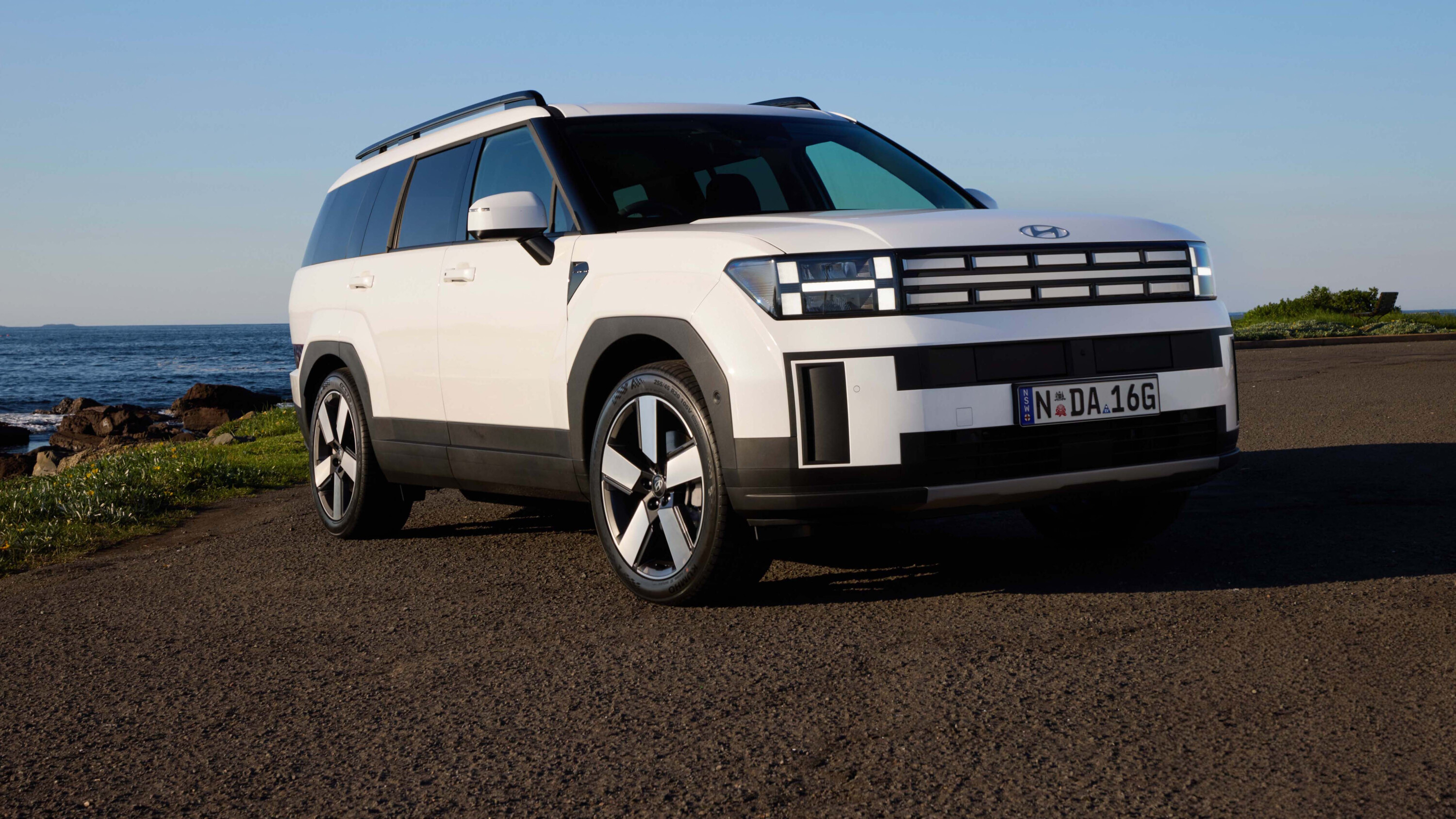
It’s also worth pointing out that for $54,950, the entry-level CX-80 is competing against the likes of the Mitsubishi Outlander and upspec Nissan X-Trails and Toyota RAV4s on price yet feels a world away in terms of what you’re getting for your money.
Mazda’s Connected Services is a new feature on the CX-80. This allows you to stay in touch with the vehicle via the MyMazda app, enabling you to locate the car, monitor its health status, send navigations instructions directly to it, track it if it’s been stolen, remote lock it, flash its lights, alert you if the vehicle is being driven outside of a user-specified geofence or curfew time and will connect to emergency services in the event of an accident.
The first three years of the subscription are complimentary, after which a fee will apply.

Interior comfort, space and storage
Those of you with a head for arcane car facts might well remember that Mazda’s old CX-8, which the CX-80 effectively replaces, was a stretched version of the CX-5.
It was built like this for the Japanese domestic market, whereas the bigger cars like the old CX-9 were export-spec only. Much the same has carried forward to today, with the ‘narrow body’ models like the five-seat CX-60 and this seven-seat CX-80 fitting into Japan’s domestic infrastructure a lot better than the behemoth wide-body CX-70 and CX-90.
Sit inside the CX-80 and you don’t immediately feel that it’s 1890mm wide, rather than the 1994mm of the more senior models. But then you don’t think of the Hyundai Santa Fe, the Volvo XC60 or the Kia Sorento – SUVs of similar width – as being particularly wasp-waisted.
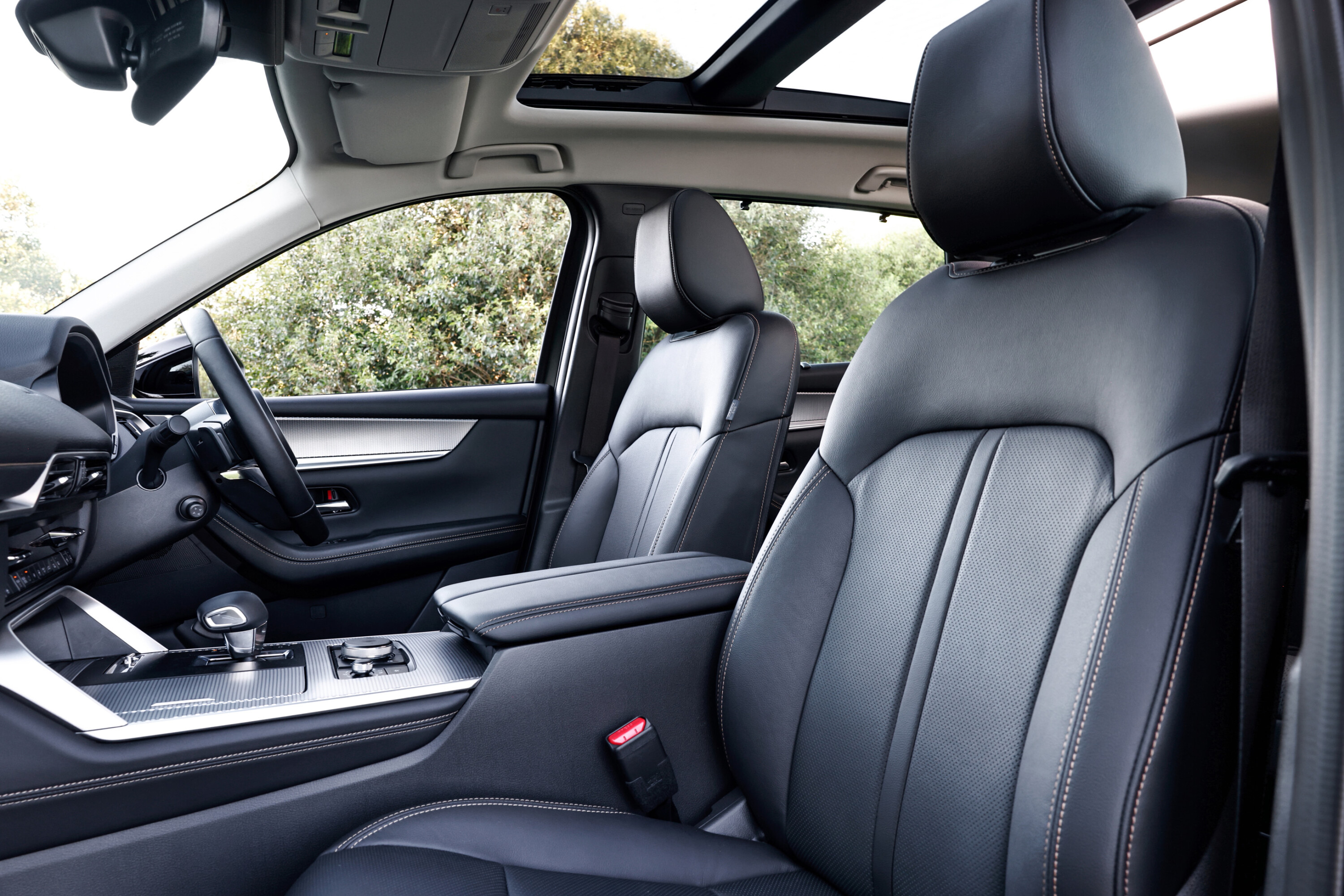
There’s a decent amount of head and elbow room up front, with stacks of adjustment for the wheel and the seating position.
All round visibility is reasonably good, with only the chunky C-pillar limiting over shoulder vision. There’s a fairly sizeable dual-lidded centre bin between the front seats, big but not huge door bins and a sensibly-sized glove box.
The infotainment system conforms to a Mazda principle whereby the designers would rather you didn’t interact with it by touching the screen on the move. Instead you use a rotary controller and the head-up display to manage information. Yes, you can set it up to act as a touchscreen, but again you’re somewhat stymied by Mazda’s dogma.
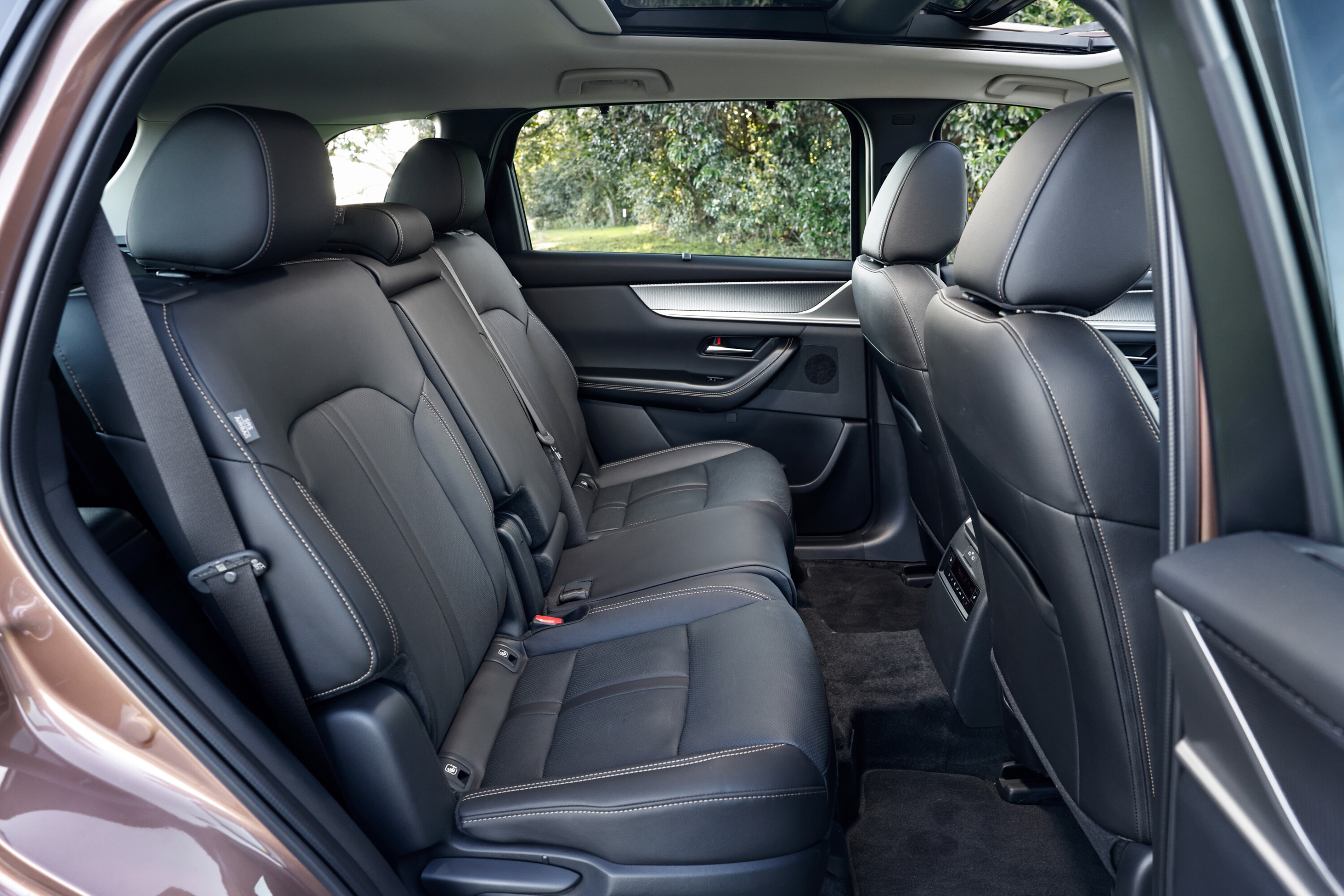
In order to not have to refocus your eyes each time you look to the touchscreen, as is the case with most cars, Mazda reckon that mounting it far way on the dash top makes driving safer.
Therefore, if you do click the option in a menu which allows you to use the touch screen while driving, you’ll find it’s too far away to easily reach. What’s more, if you do try, the heel of your hand will rest on the hazard light switch. Not ideal.
Step back a row and the middle row of seats sits high, offering a good view forwards. This will mean that taller passengers might brush their heads against the roof, not helped by a few centimetres of space robbed by the dual-pane panoramic glass roof (where fitted). There is a decent amount of recline and some slide for the second row, which makes it a lot easier to find a comfy position and legroom can be stretched right out. Even in this row, there’s a pair of USB-C slots and air con controls. Heated seats too if you spring for the GT grade and up.
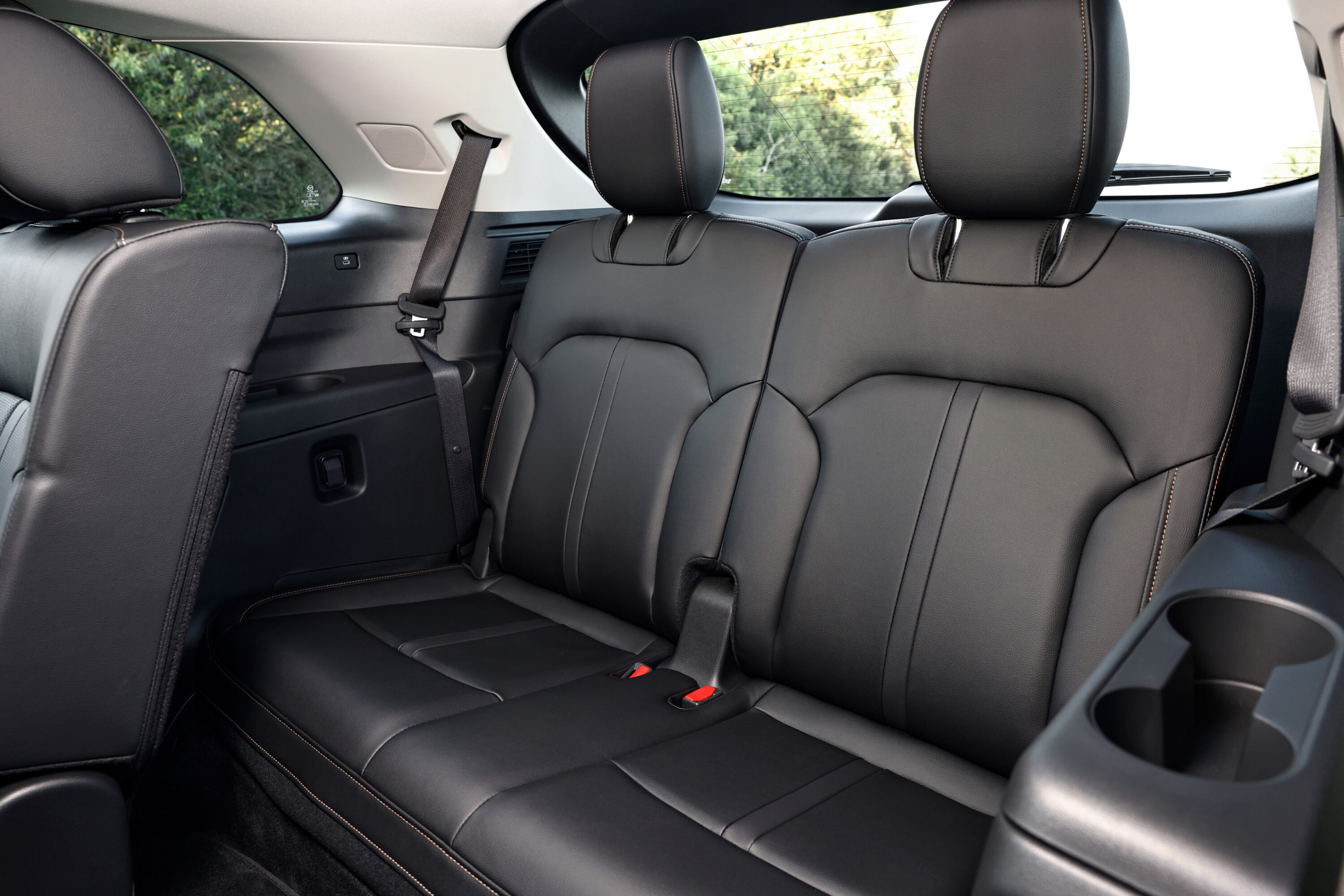
The two rearmost seats are a bit of a squeeze, the data sheets showing that there’s 54mm less shoulder room than the old CX-8 back there but 29mm more headroom. This row gets USB-C slots and its own AC vents.
With all three rows of seats in place, the CX-80 offers 258 litres of space to the seat tops, enough for a baby stroller or the ubiquitous golf bag. This figure also includes the underfloor cargo space, handy when you’re looking to keep valuables out of sight.
With the third row of seats down, the VDA figure is 566 litres, while if you really want to have you CX-80 acting like a removals truck, you can drop both rows and carry up to 1971 litres (to the head lining). And yes, when you read the words ‘underfloor cargo space’ you’d best believe that means that there’s no spare wheel and tyre set, Mazda instead providing you with a can of mobility foam and a compressor instead.
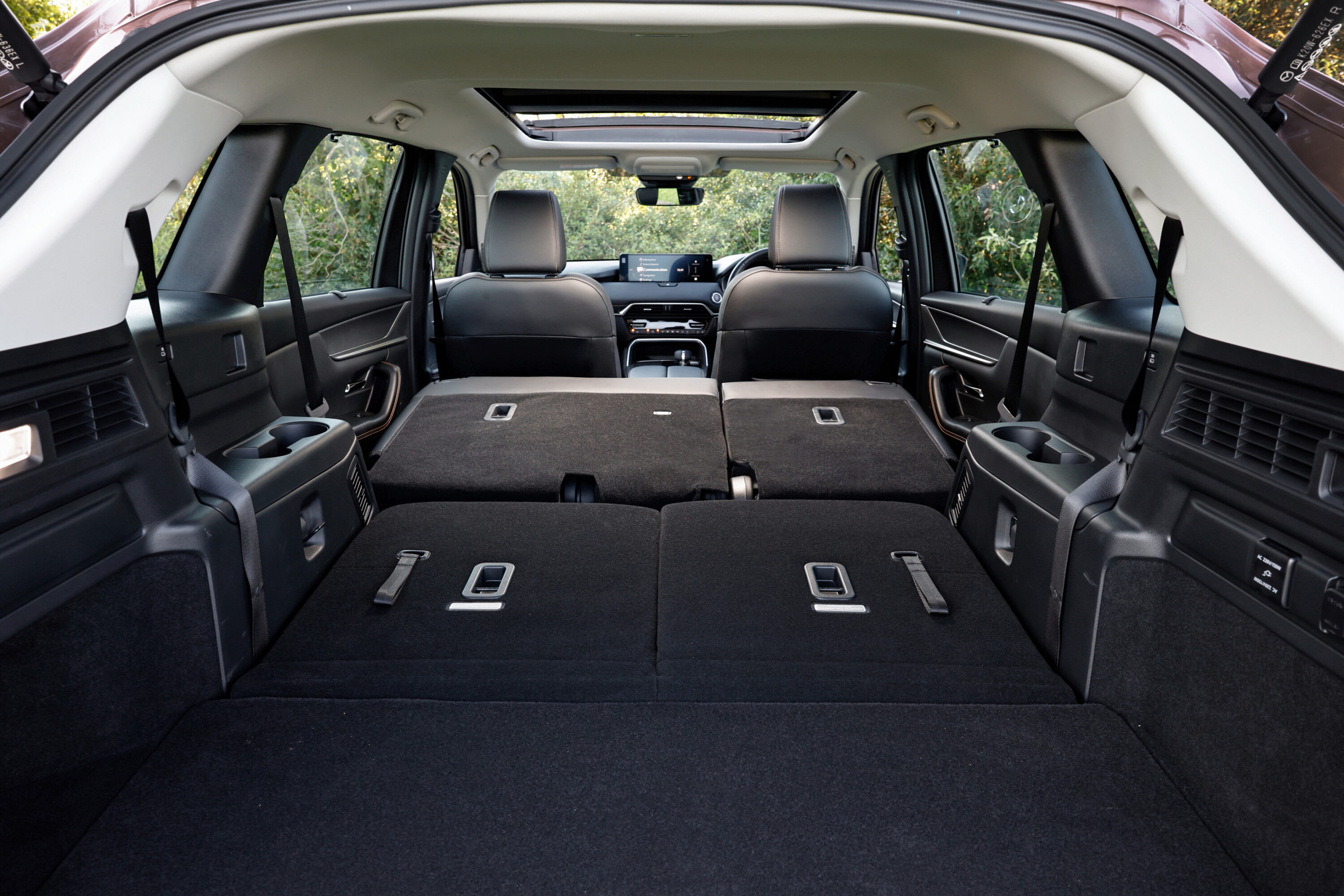
What is it like to drive?
What is the CX-80 like to drive? Before we jump into that question, let’s turn things around and consider how it ought to drive.
You won’t buy a CX-80 unless you really need seven seats because the CX-60 is available for less if you don’t need the long wheelbase and extra space. So therefore, it’s safe to assume that this is an SUV that will be bought by big families. It will be carrying your children, your children’s gear, and your significant other.
This brings with it a weight of expectation. You obviously want something unimpeachably safe and secure, but you also want something so endearingly plush to drive that your family is wafted along on a magic carpet of serenity.
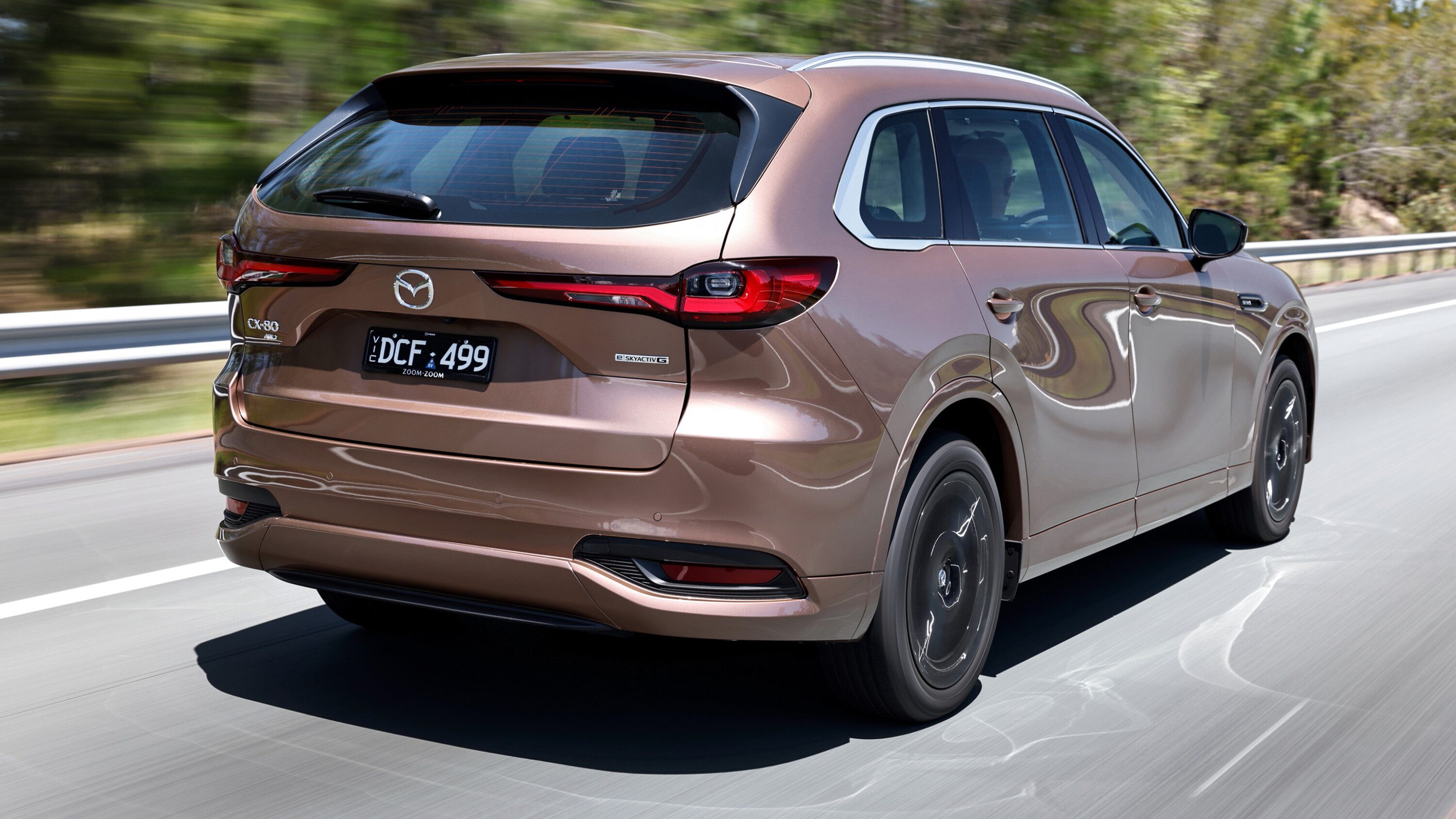
The Mazda CX-80 is not that car. It niggles and jiggles on its springs, road imperfections jolt through its superstructure and every bump that you feel as the driver is exacerbated the further back in the vehicle that you sit.
Quite how Mazda managed this with a vehicle of this size and wheelbase is utterly perplexing, because in virtually every other regard, the CX-80 is brilliant. But the ride quality could well be a deal breaker for many. Try before you buy. One caveat I’d like to mention is that all of the cars I drove were fitted with large wheels of 20 inches plus.
The entry-level Pure is fitted with an 18-inch wheel with a more generous amount of tyre sidewall, so this may well be the best riding of the lot. We’ll update this as and when we get a chance to have a spell in that version.
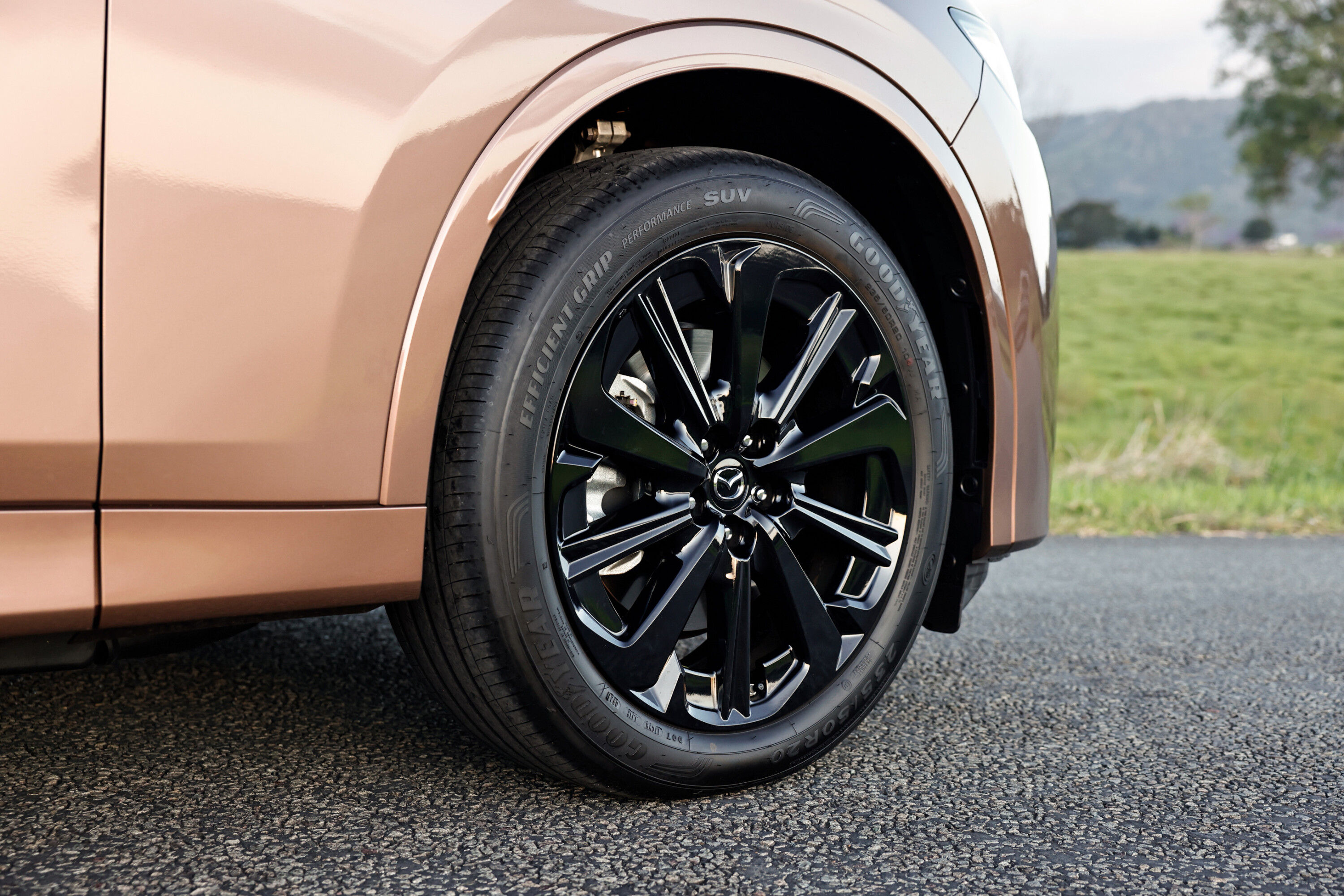
On a twisty road with good surfacing, it’s a blast to drive. It has a really strong front end and its resistance to roll is uncanny, but these are not qualities at the top of a seven-seat family SUV buyer’s shortlist.
Likewise the eight-speed transmission software has been updated such that the CX-80 isn’t afflicted by the same jolts and hesitations that afflicted earlier models built on the Large Product platform.
Special mention should be made of the brakes. The CX-80 uses 347mm ventilated discs up front and has 328mm ventilated discs at the rear (350mm for the PHEV). They offer plenty of stopping power and, in the PHEV, the handover from re-gen to friction braking is nicely judged.
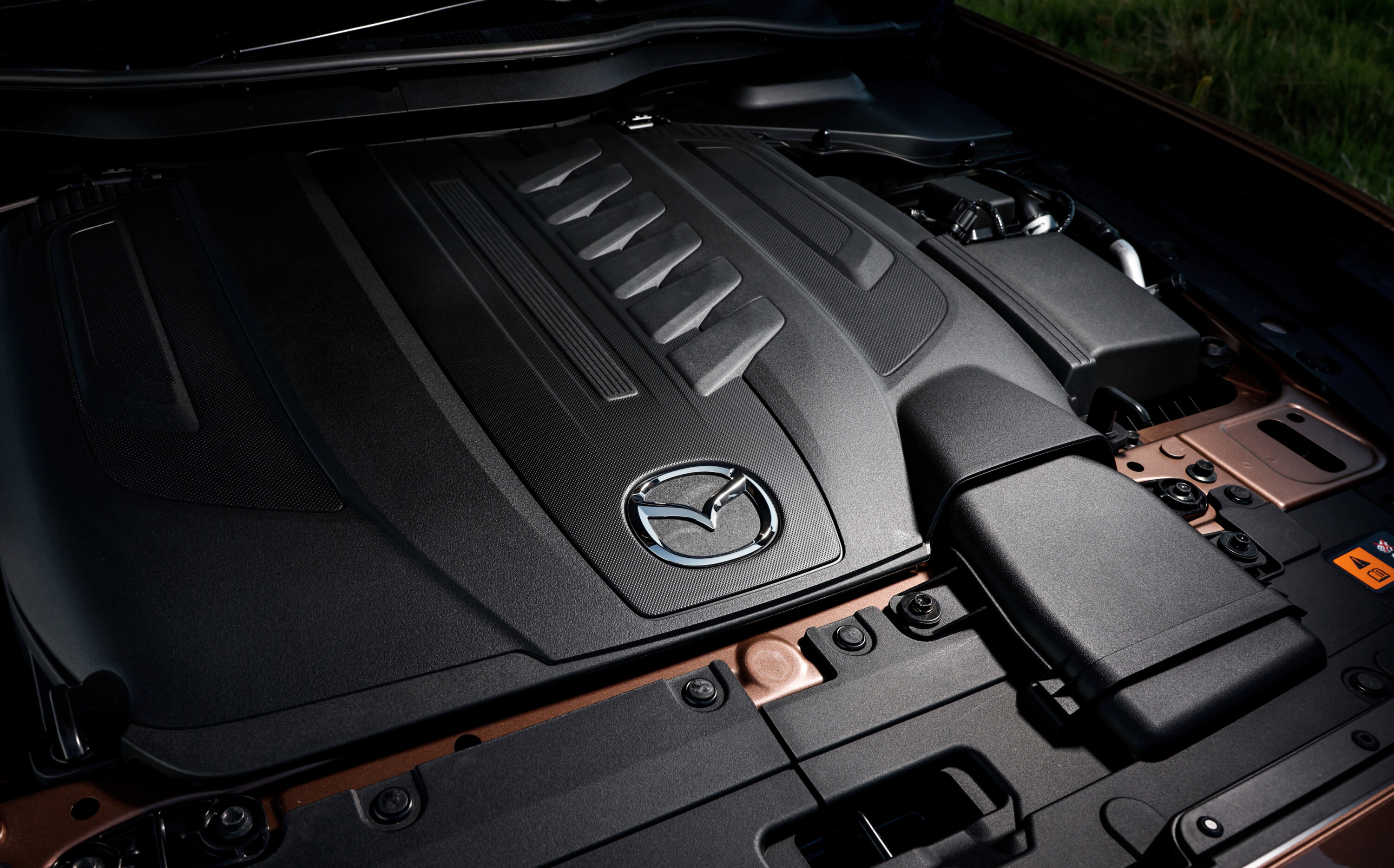
Of the three engines, the diesel probably suits the CX-80’s personality the best, offering a creamy power take up augmented by a little electrical torque fill.
Again, there is a fly in the ointment. You may well be choosing the diesel because it has the most torque (at 550Nm) in the CX-80 line up and is therefore the one to go for if you want to tow something hefty. Not so quick. At 2000kg braked, the diesel actually has the lowest towing capacity.
The plug-in hybrid and the petrol are both rated at 2500kg. When I put this to the program engineer in charge of CX-80, he said this was because of cooling limitations, which isn’t the most encouraging response in a hot climate market.

So let’s look instead at the petrol engine. No, it can’t match the diesel’s torque or fuel economy, but it sounds purposeful and, because it’s lighter, the front of the car feels more alert and less prone to pitching.
It’s where my money would go. The plug-in hybrid sips fuel and feels very pleasant when put under next to no demand. When prodded, it’s somewhat raucous which contrasts with its electric hush.
The batteries are mounted low in the car, giving it a low centre of gravity, but all of that engineering rectitude is again undone by Mazda’s blind spot over this car’s unresolved damping.
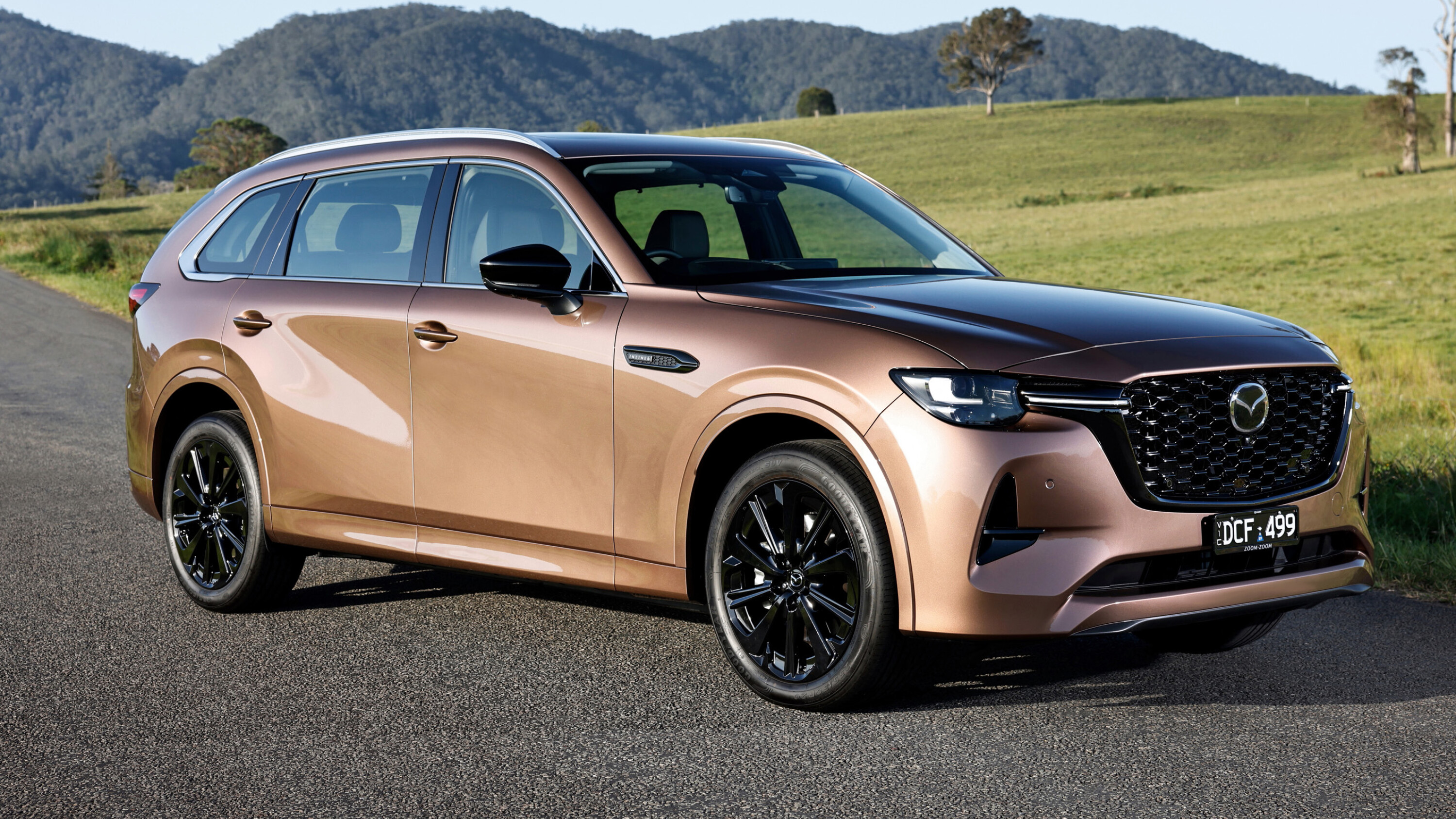
How is it on fuel?
The 3.3-litre mild-hybrid petrol engine manages a combined fuel economy figure of 8.4-litres per 100km.
If you’re running this car for three years, doing 30,000km a year and putting in 95RON at, say, $1.90 per litre, that’ll mean a three-year fuel bill of $4788. Those same mileages for the 5.2L/100km of the 3.3-litre diesel (assuming diesel fuel at a similar price) come to $2964.
As for the plug-in hybrid, that’s a tougher thing to calculate. Mazda quotes a figure of 2.7L/100km, but this is contingent on how you’re using it. If you’re commuting 30km to work and 39km home, you could conceivably do that on electric power alone, plugging in the car overnight and using zero petrol. On a cross-country drive route with some fairly press-on driving, we saw an average of 5.4L/100km.
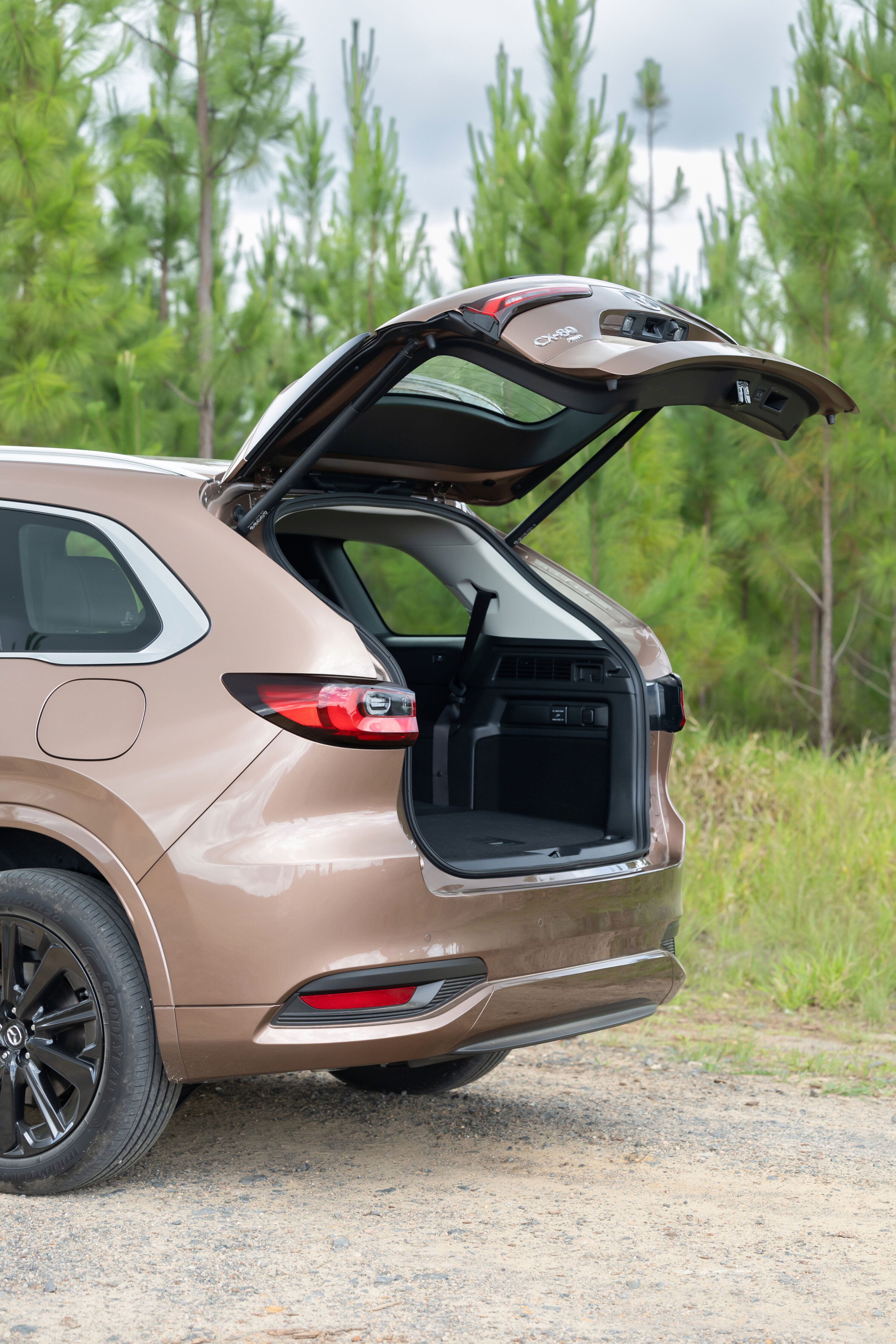
How safe is it?
The CX-80 has yet to be ANCAP tested and it’s likely to achieve a five-star score, although we naturally wouldn’t bet the house on that.
There’s a massive stack of safety kit included as standard with the CX-8 which include:
| 2025 Mazda CX-80 G40e GT safety features | |
|---|---|
| Smart Brake Support with pedestrian and cycle detection | Driver attention alert |
| Smart Brake Support Rear to stop the car if you’re about to reverse into something | Automatic emergency braking |
| Smart Brake Support Rear Crossing | ISOFIX child seat tethers x2, top tethers x9 |
| Lane Keep Assist system | Eight SRS airbags |
| Emergency Lane Keeping | High voltage protection (PHEV) |
| Blind Spot Monitoring | Tyre pressure monitoring system |
| High beam control | Whiplash-minimising front seats |
| Adaptive headlight function | Traffic sign recognition |
| Front cross-traffic alert | Hill descent control |
| Cruising and Traffic Support (Azami) | G-Vectoring Control Plus |
| Driver drowsiness monitor | |
In practice, the safety systems seem to work very well, with little in the way of false interventions, on the highway at least.
The lane keep assist can be a bit intrusive if you’re hustling along a quiet country road, often tugging annoyingly at the steering wheel. It takes quite a delve into the menus to switch it off, but it’s worth the effort for more faithful steering feel.
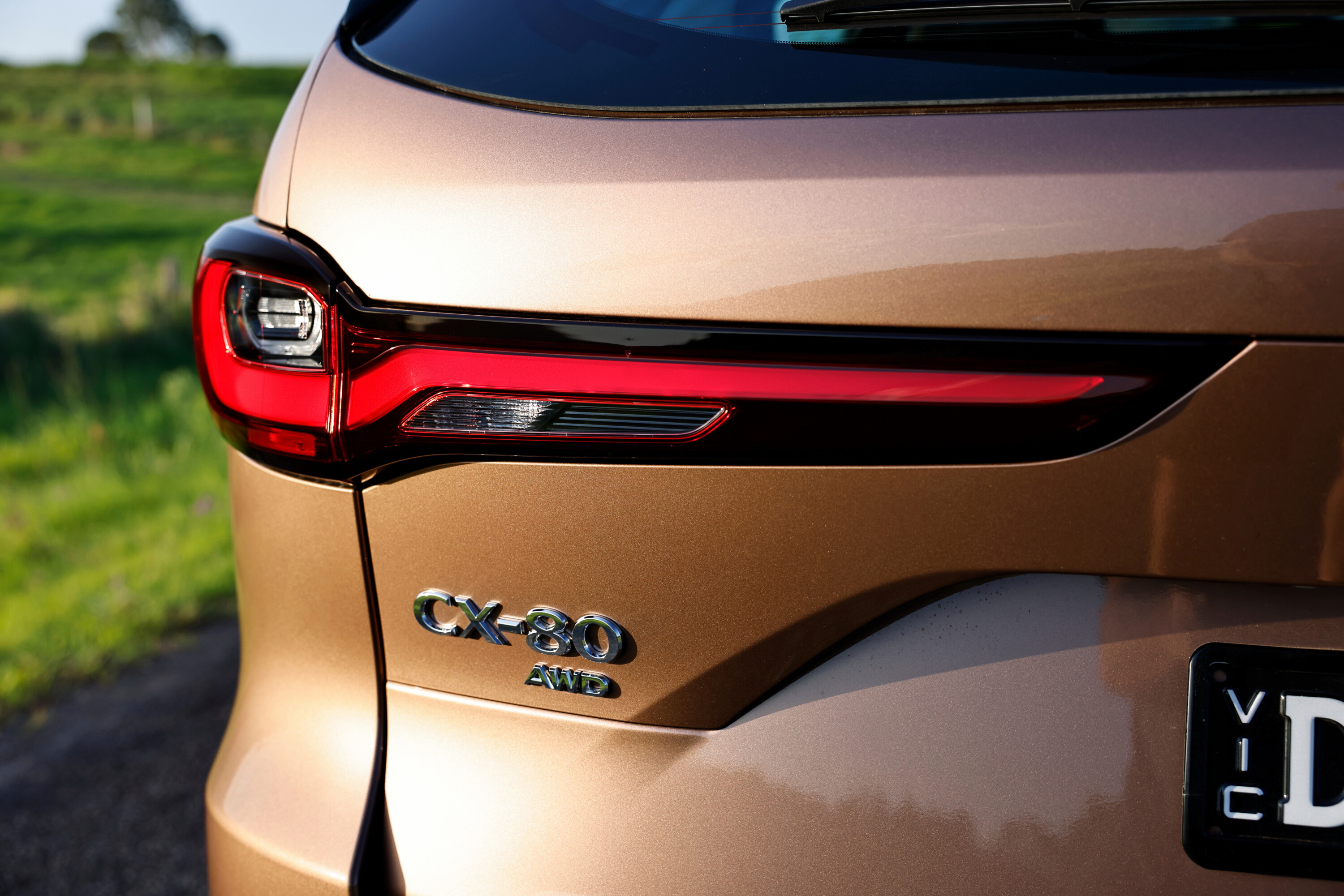
Warranty and running costs
Like the rest of the Mazda range, the CX-80 is supplied with a five-year unlimited kilometre warranty. Mazda’s five-year premium roadside assist is also part of the deal.
The servicing schedule and pricing is pretty transparent, with details for the 3.3-litre petrol listed below.
| Service event | Time/distance | Price |
|---|---|---|
| 1st service | 12 months/15,000km | $453 |
| 2nd service | 24 months/30,000km | $665 |
| 3rd service | 36 months/45,000km | $578 |
| 4th service | 48 months/60,000km | $1304 |
| 5th service | 60 months/75,000km | $469 |
The prices are maximum payable for standard scheduled servicing under normal operating conditions for the nominated months/kilometres (whichever occurs first) up to a maximum of five services.
You may be expected to pay for normal wear and tear items such as tyres and brake pads, with possible extras for maintenance for vehicles that have experienced especially hard use.

VERDICT
The Mazda CX-80 gets so much right. It’s big, the petrol and diesels are keenly priced, it’s safe, beautifully finished inside and out and looks more expensive than it is. All of the hard work appears to have yielded the right results.
The big caveat concerns this vehicle’s ride quality which, as it stands, doesn’t approach the class average. With better damping, the CX-80 could easily be challenging for class honours.
As it stands, it’s the sort of vehicle that never feels settled on the road. With a family on board, the shine will be taken off every journey due to the flinty and restless ride quality, the bouncing over road imperfections that are especially noticeable in the back and the poorly isolated noise pathways from road surface to the passenger cell.
This is such a shame and Mazda has clearly invested in this vehicle and done so much right. It needs more work. I have little doubt that this handsome and well-equipped SUV will come good but as it stands, it’s very much a case of try before you buy.
| Mazda CX-80 G40e GT specifications | |
|---|---|
| Engine | 3283cc inline-6, 24v, dohc, turbo, 48v mild hybrid |
| Max power | 209kW @ 5000-6000rpm |
| Max torque | 450Nm @ 2000-3500rpm |
| Transmission | 8-speed auto |
| Weight | 2114kg |
| Economy | 8.4L/100km (claimed) |
| 0-100km/h | 6.8sec (claimed) |
| Price | $68,950 |
| On sale | Now |
Score breakdown
Things we like
- Interior quality
- Plenty of space
- Pricing is competitive
- Interesting range of powerplants
Not so much
- Hybrid can be unrefined
- Infotainment's questionable ergonomics
- Ride quality isn't great
- Hard to cancel driver aids
We recommend
-
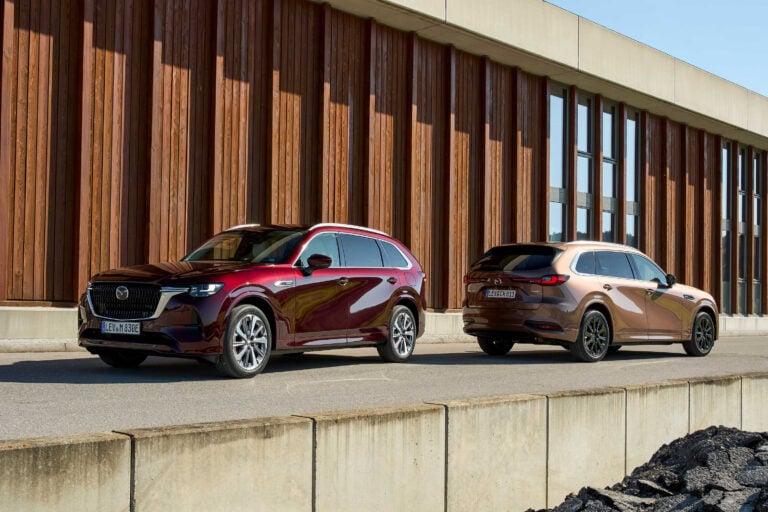 Reviews
Reviews2025 Mazda CX-80 review: First international drive
Premium, practical and punchy but is it too much, too late?
-
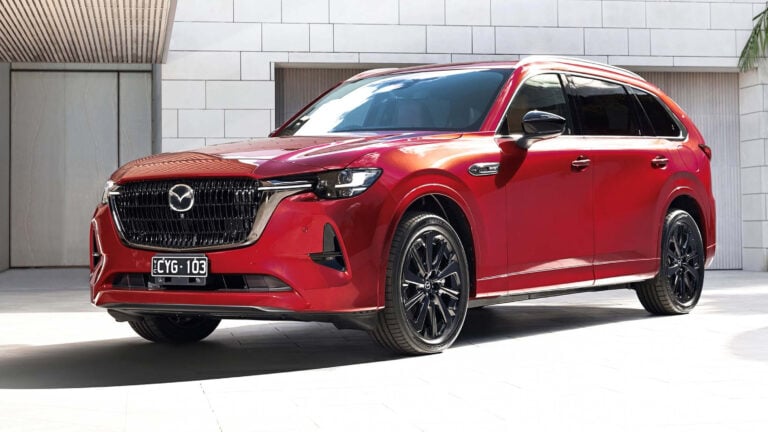 News
News2025 Mazda CX-80: Australian pricing for new 7-seat SUV
Mazda’s new CX-80, a hybrid-only seven-seat SUV, debuts in Australia with plug-in and mild-hybrid options, advanced safety, and family-focused features.
-
 News
NewsNew car calendar 2026: All the new cars coming to Australia next year
Here’s the WhichCar by Wheels guide to all the new cars that will launch in Australia in 2026. Check back in regularly for updates...






